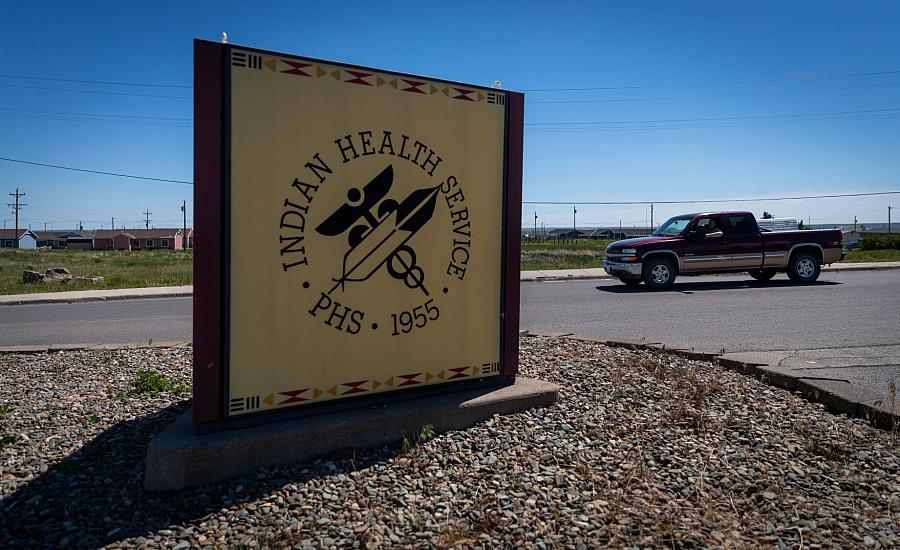Why are Native Americans in Montana dying so young?

The Blackfeet Indian Health Service unit.
Photo by Antonio Ibarra/Missoulian
The numbers are staggering.
In Montana, Native Americans die 20 years earlier than non-Natives.
Indigenous parents in Montana are dying in their 40s. Grandparents, who assume guardianship of their grandchildren, are dying in their 60s, leaving too many children and teenagers to grow up without support. But some don’t get to grow up, dying young from car crashes, violence, overdose or suicide.
A powwow dancer and cultural keeper of the Blackfeet Nation, Joe Sam Scabby Robe, died at 62. Elouise Cobell, a Blackfeet woman who famously held the federal government accountable for the mismanagement of funds and won in the largest settlement in U.S. history, died at 65. Vandree Old Person, 20, was found dead on the Blackfeet Reservation, and her case is still under investigation. And these anecdotes are from just one of the 12 tribes in Montana.
COVID-19 amplified these disparities. In 2020, COVID-19 was the leading cause of death among Native Americans in Montana. From March to October 2020, Native Americans in Montana accounted for at least 19% of COVID-19 cases and 32% of virus-related deaths; yet, they make up 6.7% of the state’s population.
My project — complete with stories, video, photos and graphics – will identify, interrogate and analyze the social determinants of health contributing to this significant life expectancy gap.
The series will focus on three tribes: the Fort Belknap Indian Community, in north-central Montana, the Fort Peck Tribes, in the eastern part of the state, and the Crow Tribe, the most populous tribe in Montana on the largest reservation.
With support from the USC Center for Health Journalism 2023 National Fellowship, I plan to travel to each of these tribal communities with a photographer and spend meaningful time there, speaking with community members, tribal leaders and health care workers, among others.
I will host community-based listening sessions at popular gathering places on reservations. There, I will ask Indigenous people — who know their communities best — what issues they’d like me to focus on, how these disparities impact their lives and what they’d like to see change. These community listening sessions will inform my reporting and guide my coverage.
To humanize the crisis, I expect one piece will examine what it’s like to grow up, live and work in a community where people die too soon. This story will examine grief, how premature deaths disrupt daily life and how the consequences transcend generations.
In another piece, I expect to follow a woman on the Fort Belknap Reservation who has made it her life’s mission to help her community access quality health care. I plan to accompany her as she takes people to appointments, disseminates resources and navigates the intricacies of the tribal health care system.
You can’t tell stories of disparity in Indigenous communities without also examining history. As I visit tribal communities, I will meet with tribal historians and community leaders to better understand the federal policies that have resulted in inequity today.
The Indian Health Service is the national entity responsible for providing health care to federally recognized tribes, and the agency has long been criticized as understaffed, underfunded and under-resourced. My project will interrogate the quality and effectiveness of Indian Health Service care and outline what the agency is doing to address the life expectancy gap.
Each tribal community is unique, and my coverage will reflect that. While I may not visit every tribe in Montana, I will collect and map life expectancy data across all 12 tribes and compare the numbers to those in metro areas such as Billings, Helena, Missoula and Great Falls. Of course, the COVID-19 pandemic will skew some data, and our maps and graphics will acknowledge that.
Essential to this project will be a story outlining solutions. It will detail what Indigenous people say they need and explain what it will take to achieve those goals, what success could look like and how potential solutions could benefit Montana as a whole. I will also examine existing solutions and collect data to test whether they’ve been effective. I’ll look at whether increased funding for Indian Health Service has made a difference, and I’ll investigate the effectiveness of grassroots efforts to make health care more accessible.
In the short term, I’d like this series to educate readers and open minds. And I’d like for Native communities to feel seen, heard and accurately reflected in this coverage. I’d also like to help amplify stories of success, so other tribal communities can be in conversation with each other and learn from one another.
Long-term, I’d like to see this series spur policy change. Ideally, this project will inspire public discourse that brings tribes and policymakers together to prompt meaningful change that makes health care more equitable.

